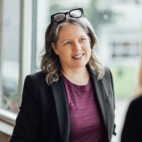Venturing out of the capital “D” design realm can be enriching.
The Moment makes time and space available for professional development. It’s one of the many great things about this organization. After working here for about a year, Karen Oikonen and myself, Kate Wilkes, decided it was a great time to take a pause from daily work and do a deep dive into learning something new. When considering which opportunities to pursue, we followed two principles:
- What hands-on activities would excite us?
- What could we bring back to share with the team and our clients?
The answer became clear: Liberating Structures. Learning from one of Liberating Structures’ top experts, Anna Jackson, Karen and I chose to head to Austin, Texas where we would spend two full days in hands-on workshops with our sleeves rolled up, ready to learn.
Liberating Structures
Liberating Structures is a series of facilitation activities designed to elevate the voices and contributions of all participants, by providing just enough structure to liberate participants to contribute equally, organically, and wholeheartedly. At The Moment, we believe strongly in hearing from a variety of voices, not just the loudest; our projects and workshops strive to bring all voices forward equally. That’s why it’s so important that we continue to learn and develop our skills as facilitators. While we’ve known about and used Liberating Structures in the past, we wanted to do a deep dive in order to help us to continue to deliver the best work, and to become better practitioners ourselves.
This two-day workshop did what we had hoped and expected: it explored supportive theory and structures in a collaborative setting, while grounding us in deeper knowledge of the practice. We also had the chance to ‘learn-by-doing’, experiencing the structures and sensing our way through the exercises from both the role of facilitator and participant. And of course, we received pro-LS (Liberating Structures) facilitator tips along the way and asked many, many questions.
We expected to gain learnings around the theory and practice of Liberated Structures, but what we gained was so much more. As we traveled back home to Toronto, we found ourselves most blown away by some unexpected learnings and reflections. We thought we would share some of those insights with you, the service design and innovation community.

Venturing out of the capital “D” design realm is enriching
Karen and I were the only people in the room that introduced ourselves as “Designers.” There was plenty of professional diversity in the crowd and we were so grateful for it. There were program directors, facilitators, start-up leaders, and independent consultants. The group was looking to LS for things like strategies in sparking new conversations, elevating teammates’ voices and contributions, polishing leadership skills, and navigating challenging topics to find alignment and understanding.
While we were attracted to LS for many of the same reasons, the range of experiences brought forward by each person added volumes to the LS learning and takeaways. Better yet, this was an example of what a bit of structure can do to open up conversations in a group, making way for unexpected and delightful wisdom from folks across sectors and organizations.
Language can be a barrier… or a gateway
If you’ve ever travelled to a foreign country, you know what a barrier language can be. Whether it’s a different language, or using language and terms that people outside an industry don’t understand, the result is the same: people get excluded.
Designers can be guilty of it, too. We use lingo that is so familiar among designers, but is not exactly the vocabulary of others. This can make people feel unintentionally excluded from the conversation at hand. Many disciplines are like this and it is important to be aware of the language we use and catch ourselves when we fall into this habit. As designers, this feels especially critical when we strive to engage others in designing services or products for them.
By contrast, rather than relying on the language of a particular sector, LS combines plain language with unique names for methods, in a sense creating a new language. This provided a shared language to work with that is new and inviting to everyone. This helps to make sure that no one feels like the lone imposter. Karen and I were impressed by this effect and immediately got thinking about opportunities to shake our own preferred lingo, and instead, ask ourselves: how might we use language to meet people where they’re at?
Confidence to adapt unlocks versatility
Liberating Structures is a bit like cooking: a confident cook can make substitutions and reinvent classic dishes, if they know what purpose the various ingredients hold. Throughout the two-days, facilitators unpacked the different structures to help us better understand the function of different elements within an activity. With this understanding, we were encouraged to adapt the structures to better tailor to whatever scenario we are applying them in.
This felt familiar. At The Moment, we strive to be T-shaped practitioners, pulling from a suite of methods in our toolbox. This allows us to borrow from a variety of methods to tailor solutions to the problem at hand. Rather than following structures strictly by the book, versatility and potential is tapped by combining and adapting the structures. Discovering that LS is designed to work in the same way as our innovation practice made us both excited by the range of possibility LS offers and the wealth of ideas that can be generated from a diverse group of people.

Change in scenery amplifies learning
While it seems obvious, hitting ‘pause’ on our day-to-day Toronto lives allowed us to sink into the learning experience. Space away from our daily demands, permission to turn off office communications (even though we really do love Slack), and being in a different time-zone (not to mention the 29 degree weather… thank you Austin) helped to shift our mindset. We were able to embrace possibilities, ideas, and experiences that tend to be more difficult to entertain amidst the noise of life. At the end of each day, we found ourselves exhausted from being immersed in learning but also energized by the knowledge, the group, and the sharing of our different perspectives. Needless to say, our evenings were marked by fascinating debriefs, delicious tacos, and a margarita (or two.)
That is a slice of the learning we had coming out of our Austin experience. We are excited to put our deeper knowledge from Liberated Structures into action and connect with the local Liberated Structures meetup group here in Toronto for more sharing.
Catch up with us soon and you can bet we’ll have more unexpected learnings to share.









